
《中级宏观经济学》课程教学大纲 The Course Syllabus of Intermediate Macroeconomics 一、课程基本信息(Basic Course Information) 课程代码:16090203 Course Code:16090203 课程名称:中级宏观经济学 Course Name:Intermediate Macroeconomics 课程类别:专业课 Course Type:Specialized Course 学 时:48 Period:48 学 分:3 Credit 3 适用对象:财经类专业本科生 Target Students:Undergraduate Students Majoring in Economics 考核方式:考试 Assessment:Examination 先修课程:初级宏观经济学,微积分 Preparatory Course:Principles of Macroeconomics,Calculus 二、课程简介(Brief Course Introduction) 中级宏观经济是为财经类本科生开设的一门重要课程。本课程通过模型与实际案 例相结合的方式,向学生介绍中级水平的宏观经济学的主要理论和相关经济政策。它 整合长期与短期、凯恩斯与古典理论,其主要内容包括:宏观经济数据,古典理论, 增长理论,经济周期理论,宏观经济政策的争论等。 Intermediate macroeconomics is an important course for undergraduates of finance and economics.This course provides students with the main theories and related economic policies of intermediate-level macroeconomics through the combination of models and actual cases.It integrates the long-run and short-run issues,Keynesian and classical theories,which include:Macroeconomic Data,Classical Theory,Growth Theory Business Cycle Theory,and Macroeconomic Policy Debates,etc
1 《中级宏观经济学》课程教学大纲 The Course Syllabus of Intermediate Macroeconomics 一、课程基本信息(Basic Course Information) 课程代码:16090203 Course Code:16090203 课程名称:中级宏观经济学 Course Name:Intermediate Macroeconomics 课程类别:专业课 Course Type: Specialized Course 学 时:48 Period: 48 学 分:3 Credit: 3 适用对象: 财经类专业本科生 Target Students: Undergraduate Students Majoring in Economics 考核方式:考试 Assessment: Examination 先修课程:初级宏观经济学,微积分 Preparatory Course: Principles of Macroeconomics, Calculus 二、课程简介(Brief Course Introduction) 中级宏观经济是为财经类本科生开设的一门重要课程。本课程通过模型与实际案 例相结合的方式,向学生介绍中级水平的宏观经济学的主要理论和相关经济政策。它 整合长期与短期、凯恩斯与古典理论,其主要内容包括:宏观经济数据,古典理论, 增长理论,经济周期理论,宏观经济政策的争论等。 Intermediate macroeconomics is an important course for undergraduates of finance and economics. This course provides students with the main theories and related economic policies of intermediate-level macroeconomics through the combination of models and actual cases. It integrates the long-run and short-run issues, Keynesian and classical theories, which include: Macroeconomic Data, Classical Theory, Growth Theory, Business Cycle Theory, and Macroeconomic Policy Debates, etc
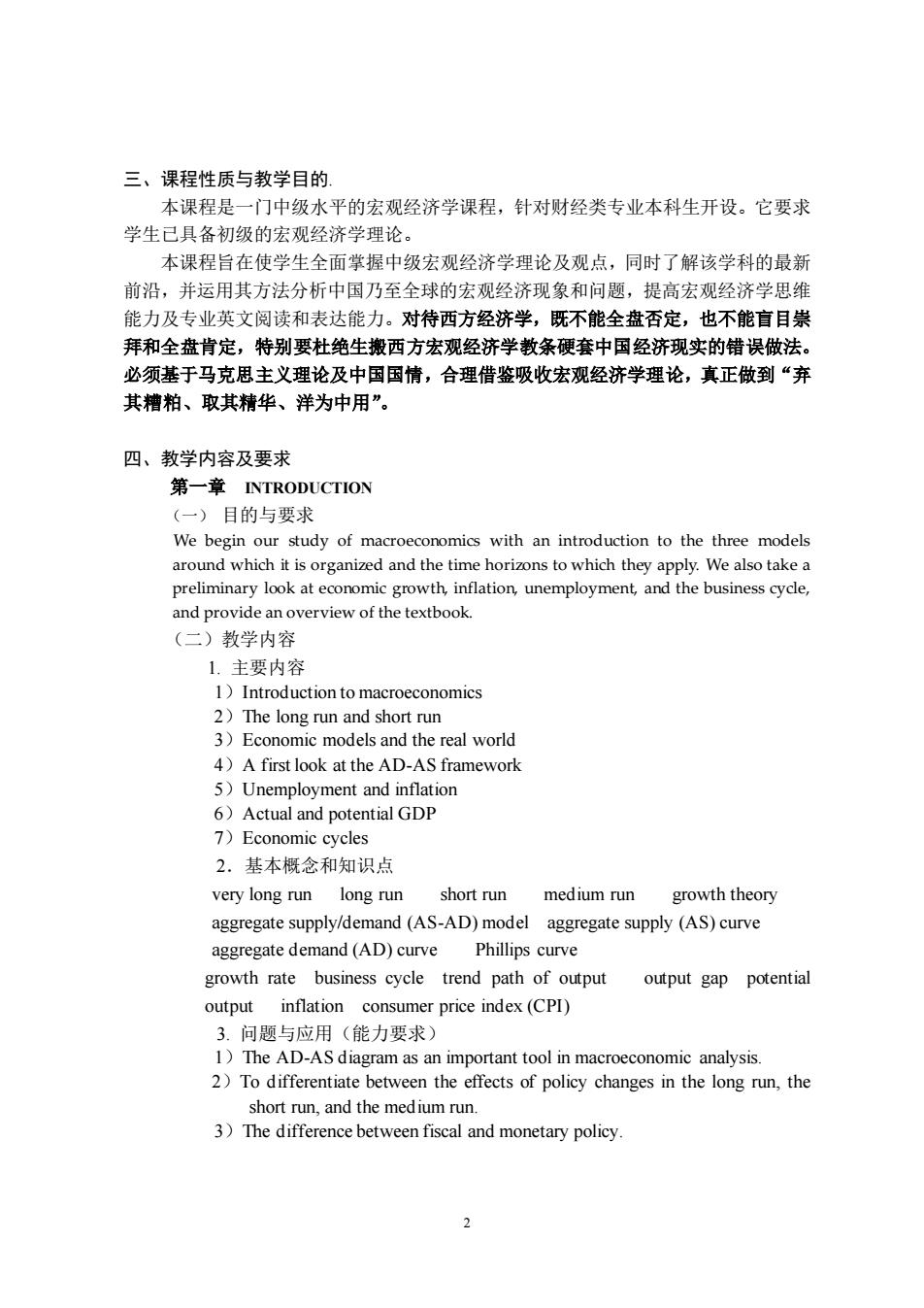
三、课程性质与教学目的, 本课程是一门中级水平的宏观经济学课程,针对财经类专业本科生开设。它要求 学生己具备初级的宏观经济学理论。 本课程旨在使学生全面掌握中级宏观经济学理论及观点,同时了解该学科的最新 前沿,并运用其方法分析中国乃至全球的宏观经济现象和问题,提高宏观经济学思维 能力及专业英文阅读和表达能力。对特西方经济学,既不能全盘否定,也不能盲目崇 拜和全盘肯定,特别要杜绝生搬西方宏观经济学教条硬套中国经济现实的错误做法。 必须基于马克思主义理论及中国国情,合理借鉴吸收宏观经济学理论,真正做到“弃 其糟粕、取其精华、洋为中用”。 四、教学内容及要求 第一章INTRODUCTION (一)目的与要求 We begin our study of macroeconomics with an introduction to the three models around which it is organized and the time horizons to which they apply.We also take a preliminary look at economic growth,inflation,unemployment,and the business cycle, and provide an overview of the textbook. (二)教学内容 1.主要内容 1)Introduction to macroeconomics run e real world 4)A first look at the AD-AS framework 5)Unemployment and inflation 6)Actual and potential GDp 7)Ec cycles 2.基本概念和知识点 very long run long rur short run medium run growth theory aggregate supply/demand(AS-AD)model aggregate supply (AS)curve aggregate demand(AD)curve Phillips curve growth rate business cycle trend path of output output gap potential output inflation consumer price index(CPI) 3.问题与应用(能力要求) 1)The AD-AS diagram as an important tool in macroeconomic analysis. 2To differentiate between the effects of policy changes in the long run,the short run,and the medium run. 3)The difference between fiscal and monetary policy. 2
2 三、课程性质与教学目的. 本课程是一门中级水平的宏观经济学课程,针对财经类专业本科生开设。它要求 学生已具备初级的宏观经济学理论。 本课程旨在使学生全面掌握中级宏观经济学理论及观点,同时了解该学科的最新 前沿,并运用其方法分析中国乃至全球的宏观经济现象和问题,提高宏观经济学思维 能力及专业英文阅读和表达能力。对待西方经济学,既不能全盘否定,也不能盲目崇 拜和全盘肯定,特别要杜绝生搬西方宏观经济学教条硬套中国经济现实的错误做法。 必须基于马克思主义理论及中国国情,合理借鉴吸收宏观经济学理论,真正做到“弃 其糟粕、取其精华、洋为中用”。 四、教学内容及要求 第一章 INTRODUCTION (一) 目的与要求 We begin our study of macroeconomics with an introduction to the three models around which it is organized and the time horizons to which they apply. We also take a preliminary look at economic growth, inflation, unemployment, and the business cycle, and provide an overview of the textbook. (二)教学内容 1. 主要内容 1)Introduction to macroeconomics 2)The long run and short run 3)Economic models and the real world 4)A first look at the AD-AS framework 5)Unemployment and inflation 6)Actual and potential GDP 7)Economic cycles 2.基本概念和知识点 very long run long run short run medium run growth theory aggregate supply/demand (AS-AD) model aggregate supply (AS) curve aggregate demand (AD) curve Phillips curve growth rate business cycle trend path of output output gap potential output inflation consumer price index (CPI) 3. 问题与应用(能力要求) 1)The AD-AS diagram as an important tool in macroeconomic analysis. 2)To differentiate between the effects of policy changes in the long run, the short run, and the medium run. 3)The difference between fiscal and monetary policy

4)To interpret economic indicators and understand their importance in assessing 5eofmtho o theydevpd from the problems of the time in which they were formed. (三)思考与实践 1 What macroeconomic issues have been in the news lately? 2)How to evaluate macroeconomics from the perspective of Marxism? (四)教学方法与手段 课堂讲授,名煤体教学,课堂过论或分组计论 第二章NATIONALINCOMEACCOUNTING (一)目的与要求 1.Under the heading"national income accounting"we consider the different ways in which the national economic pie can be sliced into its component 2 is more than just simple accounting.While we dissect GDP we are actually learning how the many sources of aggregate demand can be added together to determine total national income,and just why a nation's income and output must necessarily be the same. (二)教学内容 1。主要内容 1 The Production of Output and Payments to Factors of Production Y=(wx N)+(ix K)+profit 2)Outlays and Components of Demand 3)Some Important Identities 4)Y=C+I+G+NX fundamental national income accounting identity V-YR R- BD=G+TR-TA definition of the budget deficit S-I=(G+TR-TA)+NX 5)Measuring Gross Domestic Product 6)Inflation and Price Indices 7)Unemployment 8)Interest Rates and Real Interest Rates 9)Exchange Rates 2.基本概念和知识点 Gross domestic product(GDP) Consumer price index(CPI) 3
3 4)To interpret economic indicators and understand their importance in assessing current economic trends. 5)The different schools of macroeconomic thought and how they developed from the problems of the time in which they were formed. (三) 思考与实践 1)What macroeconomic issues have been in the news lately? 2)How to evaluate macroeconomics from the perspective of Marxism? (四)教学方法与手段 课堂讲授,多媒体教学,课堂讨论或分组讨论。 第二章 NATIONAL INCOME ACCOUNTING (一)目的与要求 1. Under the heading “national income accounting,” we consider the different ways in which the national economic pie can be sliced into its component parts. 2.This is more than just simple accounting. While we dissect GDP, we are actually learning how the many sources of aggregate demand can be added together to determine total national income, and just why a nation’s income and output must necessarily be the same. (二)教学内容 1.主要内容 1) The Production of Output and Payments to Factors of Production Y = (w x N) + (i x K) + profit 2)Outlays and Components of Demand 3)Some Important Identities 4)Y = C + I + G + NX fundamental national income accounting identity YD = C + S uses of disposable income YD= Y + TR – TA sources of disposable income BD = G + TR – TA definition of the budget deficit S - I = (G + TR - TA) + NX 5)Measuring Gross Domestic Product 6)Inflation and Price Indices 7)Unemployment 8)Interest Rates and Real Interest Rates 9)Exchange Rates 2.基本概念和知识点 Gross domestic product (GDP) Consumer price index (CPI)
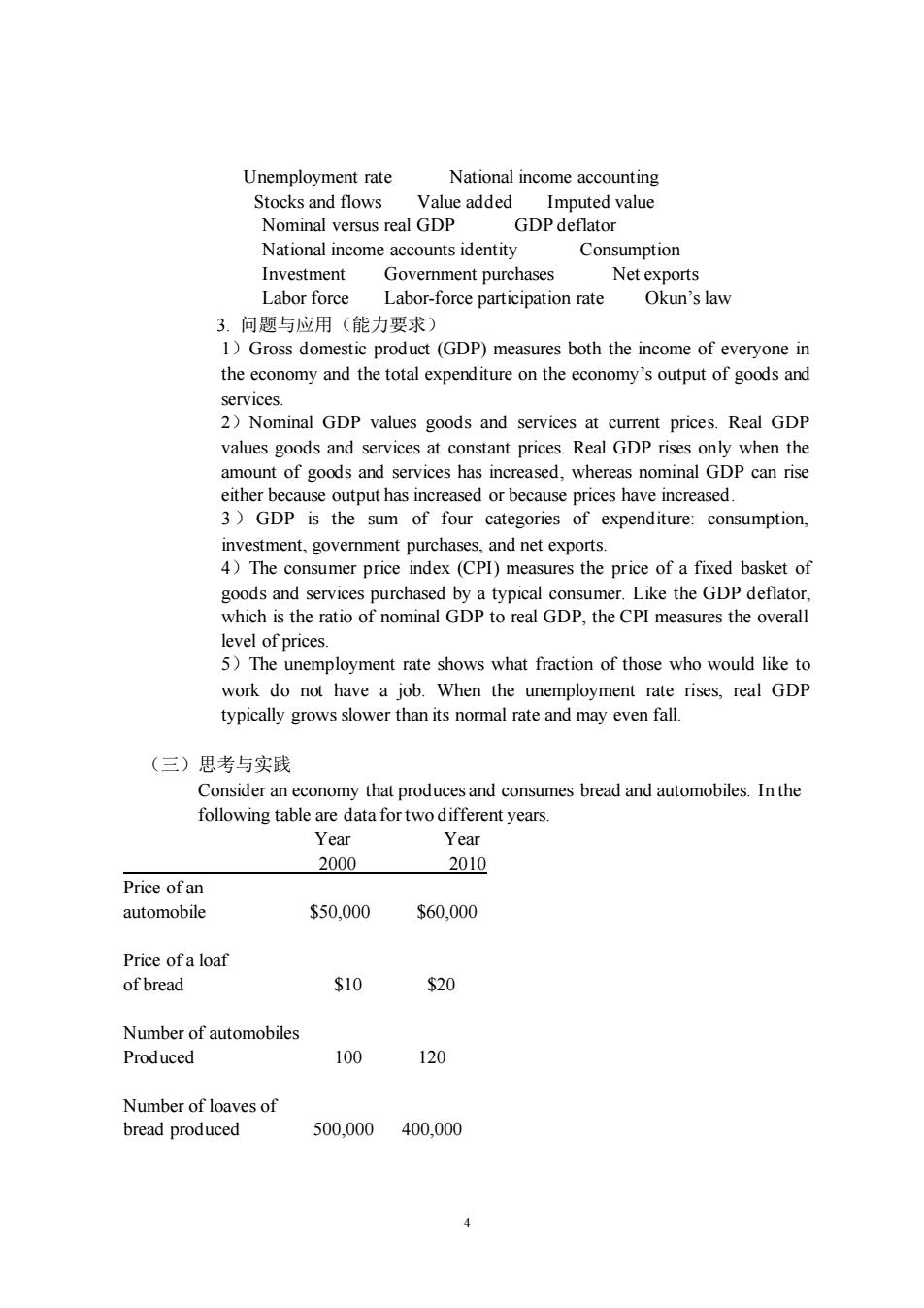
Unemployment rate National income accounting Stocks and flows Value added Imputed value Nominal versus real GDP GDP deflator National income accounts identity Consumption Investment Net exports Labor force Labor-force participation rate Okun's law 3.问题与应用(能力要求) 1ross domestic product (GDP)measures both the incm of everyoe in the economy and the services. 2)Nominal GDp values goods and services at current prices.Real GDp values goods and services at constant prices.Real GDP rises only when the amon of os and has increased,where nomi al gde can rise pu as reased or because prices have inc ased 3)GDP is the sum of four categories of expenditure:consumption, investment,government purchases,and net exports. 4)The consumer price index(CPI)measures the price of a fixed basket of urchased by a t er.Like the GDP deflator th atio typical consu of nominal GDP to real GDP,the CPI measures the overal level of prices 5)The unemployment rate shows what fraction of those who would like to work do not have a job.When the unemployment rate rises,real GDP typically grows slower than its normal rate and may even fall. (三)思考与实践 Consider an economy that produces and consumes bread and automobiles.In the following table are data fortwo different years. Year 2000 2010 Price of an automobile $50000 $60.000 Price ofa loaf of bread $10 $20 Number of automobiles Produced 100 120 500.000 400,000 4
4 Unemployment rate National income accounting Stocks and flows Value added Imputed value Nominal versus real GDP GDP deflator National income accounts identity Consumption Investment Government purchases Net exports Labor force Labor-force participation rate Okun’s law 3. 问题与应用(能力要求) 1)Gross domestic product (GDP) measures both the income of everyone in the economy and the total expenditure on the economy’s output of goods and services. 2)Nominal GDP values goods and services at current prices. Real GDP values goods and services at constant prices. Real GDP rises only when the amount of goods and services has increased, whereas nominal GDP can rise either because output has increased or because prices have increased. 3 ) GDP is the sum of four categories of expenditure: consumption, investment, government purchases, and net exports. 4)The consumer price index (CPI) measures the price of a fixed basket of goods and services purchased by a typical consumer. Like the GDP deflator, which is the ratio of nominal GDP to real GDP, the CPI measures the overall level of prices. 5)The unemployment rate shows what fraction of those who would like to work do not have a job. When the unemployment rate rises, real GDP typically grows slower than its normal rate and may even fall. (三)思考与实践 Consider an economy that produces and consumes bread and automobiles. In the following table are data for two different years. Year Year 2000 2010 Price of an automobile $50,000 $60,000 Price of a loaf of bread $10 $20 Number of automobiles Produced 100 120 Number of loaves of bread produced 500,000 400,000

a.Using the year 2000 as the base year,compute the following statistics for each year nominal GDP,real GDP,the implicit price deflator for GDP,and a fixed-weight price index such as the CPl b.How much have prices risen between year 2012 and year 2016?Compare the answers given by the Laspeyres and Paasche price indices.Explain the difference c.Suppose you are a senator writing a bill to index Social Security and federal pensions That is your bill will adiust these benefits to offset changes in the cost of iving.Will you use the GDP deflator or the CPI?Why? (四)教学方法与手段 课堂讲授,多媒体教学,课堂讨论或分组讨论 第三章GROWTHAND ACCUMULATION (一)目的与要求 1.In this chapter we study how potential output-the output that would be produced if all factors were fully employed-grows over time. 2 To better accon lish this.we leam gr wth ting and the fundamentals of neoclassical growth theory. Together,they tell us that output growth results both from improvements in technology and from increases in one or more of the inputs to the production process-capital,labor,and natural resources.Neoclassical growth theory also tells us that in the long run,growth in potential output results ntirely from technological improvement (二)教学内容 1,主要内容 1)GrowthAccounting Growth accounting The Cobb-Douglas production function The marginal product of labor and capital 2)Empirical Estimates of Growth Convergence Total factor productivity The importance of human capital 3)Growth Theory The Neoclassical Model The neoclassical growth model The steady-state equilibrium: sfik)=(n d)k* krepresents the steady-state value of k.The steady-state value ofy isy"f(k). The golden-rule capital stock
5 _______________________________________ a. Using the year 2000 as the base year, compute the following statistics for each year: nominal GDP, real GDP, the implicit price deflator for GDP, and a fixed-weight price index such as the CPI. b. How much have prices risen between year 2012 and year 2016? Compare the answers given by the Laspeyres and Paasche price indices. Explain the difference. c. Suppose you are a senator writing a bill to index Social Security and federal pensions. That is, your bill will adjust these benefits to offset changes in the cost of living. Will you use the GDP deflator or the CPI? Why? (四)教学方法与手段 课堂讲授,多媒体教学,课堂讨论或分组讨论。 第三章 GROWTH AND ACCUMULATION (一)目的与要求 1. In this chapter we study how potential output⎯the output that would be produced if all factors were fully employed⎯grows over time. 2. To better accomplish this, we learn growth accounting and the fundamentals of neoclassical growth theory. Together, they tell us that output growth results both from improvements in technology and from increases in one or more of the inputs to the production process⎯capital, labor, and natural resources. Neoclassical growth theory also tells us that in the long run, growth in potential output results entirely from technological improvement. (二)教学内容 1.主要内容 1) Growth Accounting Growth accounting The Cobb-Douglas production function The marginal product of labor and capital 2) Empirical Estimates of Growth Convergence Total factor productivity The importance of human capital 3) Growth Theory: The Neoclassical Model The neoclassical growth model The steady-state equilibrium : sf(k*) = (n + d)k* k* represents the steady-state value of k. The steady-state value of y is y* = f(k*). The golden-rule capital stock
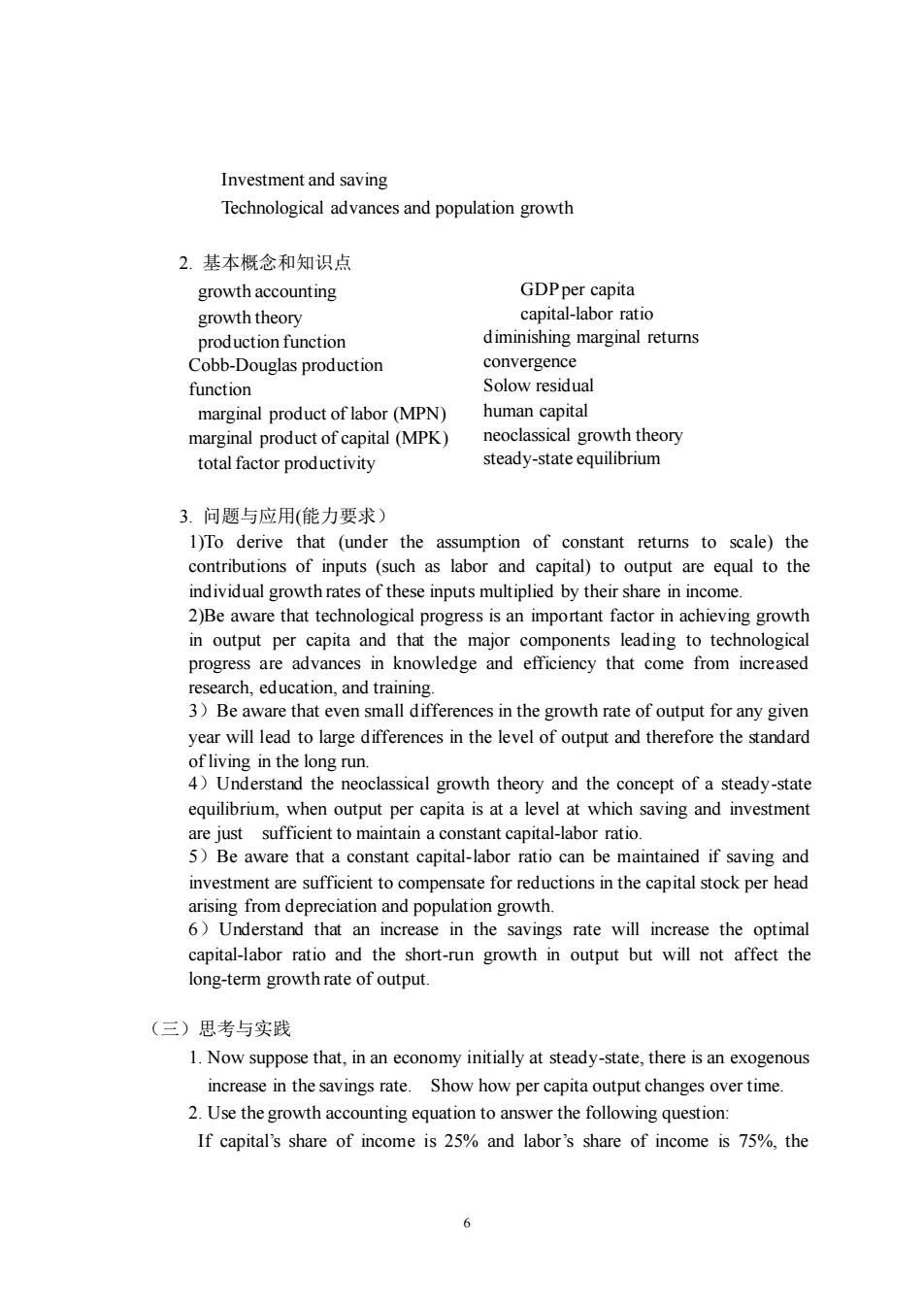
Investment and saving Technological advances and population growth 2.基本概念和知识点 growth accounting GDPper capita growth theory capital-labor ratio production function diminishing marginal retumns Cobb-Douglas production function marginal product of labor (MPN) human capital marg inal product of capital(MPK) neoclassical growth theory total factor productivity steady-state equilibrium 3.问题与应用(能力要求) 1)To derive that (under the assumption of constant retums to scale)the contributions of inputs (such as labor and capital)to output are equal to the individual growth rates of these inputs multiplied by their share in income. 2)Be aware that technological progress is an important facto in achie owth in output per capita and tha th majo onents ad ing to technologic progress are advances in knowledge and efficiency that come from increased research.education,and training. 3)Be aware that even small differences in the growth rate of output for any given year will lead to large differences in the level of output and therefore the standard Understand equilibrium,when output per capita is at a level at which saving and investment are just sufficient to maintain a constant capital-labor ratio. 5)Be aware that a constant capital-labor ratio can be maintained if saving and investment are sufficient to compensate for reductions in the capital stock per head epreciation and populati dthat an inenease in the savings rate will increase the optimal n growth capital-labor ratio and the short-run growth in output but will not affect the long-term growth rate of output (三)思考与实践 1.Now suppose that,in an economy initially at steady-state,there is an exogenous increase in the savings rate.Show how per capita output changes over time 2.Use the growth accounting equation to answer the following question: If capital's share of income is 25%and labor's share of income is 75%,the 6
6 Investment and saving Technological advances and population growth 2. 基本概念和知识点 growth accounting growth theory production function Cobb-Douglas production function marginal product of labor (MPN) marginal product of capital (MPK) total factor productivity GDP per capita capital-labor ratio diminishing marginal returns convergence Solow residual human capital neoclassical growth theory steady-state equilibrium 3. 问题与应用(能力要求) 1)To derive that (under the assumption of constant returns to scale) the contributions of inputs (such as labor and capital) to output are equal to the individual growth rates of these inputs multiplied by their share in income. 2)Be aware that technological progress is an important factor in achieving growth in output per capita and that the major components leading to technological progress are advances in knowledge and efficiency that come from increased research, education, and training. 3)Be aware that even small differences in the growth rate of output for any given year will lead to large differences in the level of output and therefore the standard of living in the long run. 4)Understand the neoclassical growth theory and the concept of a steady-state equilibrium, when output per capita is at a level at which saving and investment are just sufficient to maintain a constant capital-labor ratio. 5)Be aware that a constant capital-labor ratio can be maintained if saving and investment are sufficient to compensate for reductions in the capital stock per head arising from depreciation and population growth. 6)Understand that an increase in the savings rate will increase the optimal capital-labor ratio and the short-run growth in output but will not affect the long-term growth rate of output. (三)思考与实践 1. Now suppose that, in an economy initially at steady-state, there is an exogenous increase in the savings rate. Show how per capita output changes over time. 2. Use the growth accounting equation to answer the following question: If capital’s share of income is 25% and labor’s share of income is 75%, the
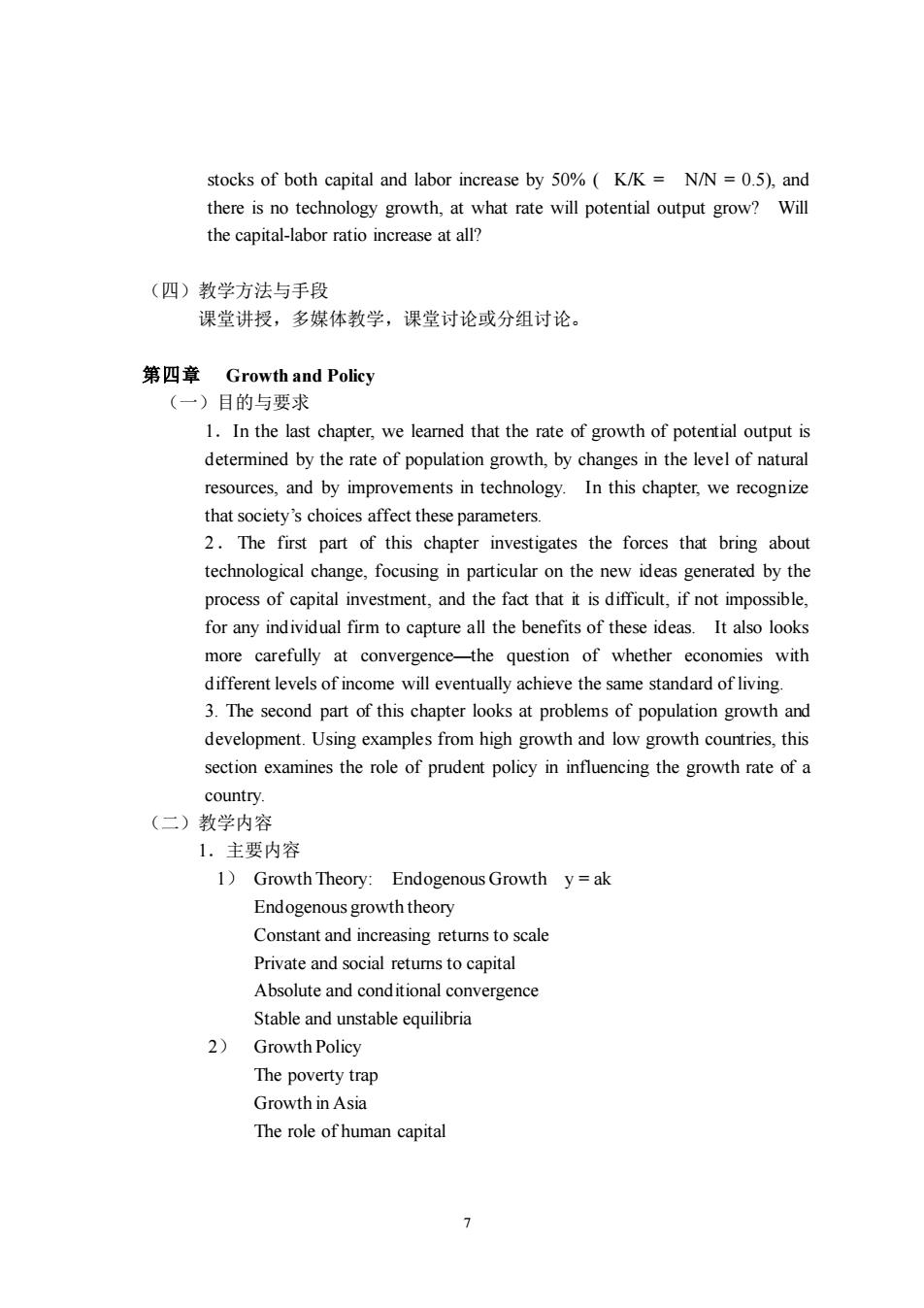
stocks of both capital and labor increase by 50%(K/K N/N=0.5),and there is no technology growth,at what rate will potential output grow? Wil the capital-labor ratio increase at all? (四)教学方法与手段 课堂讲授,多媒体教学,课堂讨论或分组讨论。 第四章Growth and Policy (一)目的与要求 1.In the last chapter,we leamed that the rate of growth of potential output is determined by the rate of population growth,by changes in the level of natural resources,and by improvements in technology.In this chapter,we recognize that society's choices affect these parameters 2.The first part of this chapter investigates the forces that bring about technological change,focusing in particular on the new ideas generated by the process of capital investment,and the fact that it is difficult,if not impossible, for any individual firm to capture all the benefits of these ideas.It also looks more carefully at convergence-the question of whether economies with different levels of income will eventually achieve the same standard of living 3.The second part of this chapter looks at problems of population growth and development.Using examples from high growth and low growth countries,this section examines the role of prudent policy in influencing the growth rate of a country. (二)教学内容 1.主要内容 1)Growth Theory:Endogenous Growth y=ak Endogenous growth theory Constant and increasing retums to scale Private and social retums to capital Absolute and conditional convergence Stable and unstable equilibria 2)Growth Policy The poverty trap Growth in Asia The role of human capital
7 stocks of both capital and labor increase by 50% ( K/K = N/N = 0.5), and there is no technology growth, at what rate will potential output grow? Will the capital-labor ratio increase at all? (四)教学方法与手段 课堂讲授,多媒体教学,课堂讨论或分组讨论。 第四章 Growth and Policy (一)目的与要求 1.In the last chapter, we learned that the rate of growth of potential output is determined by the rate of population growth, by changes in the level of natural resources, and by improvements in technology. In this chapter, we recognize that society’s choices affect these parameters. 2.The first part of this chapter investigates the forces that bring about technological change, focusing in particular on the new ideas generated by the process of capital investment, and the fact that it is difficult, if not impossible, for any individual firm to capture all the benefits of these ideas. It also looks more carefully at convergence⎯the question of whether economies with different levels of income will eventually achieve the same standard of living. 3. The second part of this chapter looks at problems of population growth and development. Using examples from high growth and low growth countries, this section examines the role of prudent policy in influencing the growth rate of a country. (二)教学内容 1.主要内容 1) Growth Theory: Endogenous Growth y = ak Endogenous growth theory Constant and increasing returns to scale Private and social returns to capital Absolute and conditional convergence Stable and unstable equilibria 2) Growth Policy The poverty trap Growth in Asia The role of human capital

Limits to growth 2.基本概念和知识点 endogenousgrowth increasing retums to scale absolute convergence conditional convergence stable equilibrium unstable equilibrium golden-rule capital stock 3.问题与应用(能力要求) 1)Students should be able to distinguish between exogenous and endogenous growth. 2)Students should be familiar with the concept of an aggregate production function that displays constant,increasing,or decreasing retums to scale. 3)Students should know that endogenous growth theory can imply that technological progress can be fostered by govemment policies. 4)Students should be aware that technological progress is an important factor in achieving growth in output per capita and that the major components leading to technological progress are advances in knowledge and efficiency that come from increased research,education,and training. 5)Students should be able to distinguish between private and social returns to capital. Students should be aware that,contrary to the prediction of the endogenous growth model,the notion of conditional convergence seems to hold,that is, countries with higher savings rates most often are not able to achieve highe long-term growth rates. 6)Students should be able to evaluate the options available to developing nations for increasing their economic growth rate.This includes the lessons learned from the Asian Tigers as well as strategies to help poor countries escape the poverty trap (三)思考与实践 1.Consider the following neoclassical production function:Y=K a)Write this production function in per capita form b)Find the golden rule level of the (steady-state)capital-labor ratio,when the rat of depreciation is 0.05.and the (exogenous)rate of population growth is 0.20
8 Limits to growth 2. 基本概念和知识点 endogenous growth increasing returns to scale absolute convergence conditional convergence stable equilibrium unstable equilibrium golden-rule capital stock 3. 问题与应用(能力要求) 1)Students should be able to distinguish between exogenous and endogenous growth. 2)Students should be familiar with the concept of an aggregate production function that displays constant, increasing, or decreasing returns to scale. 3)Students should know that endogenous growth theory can imply that technological progress can be fostered by government policies. 4)Students should be aware that technological progress is an important factor in achieving growth in output per capita and that the major components leading to technological progress are advances in knowledge and efficiency that come from increased research, education, and training. 5)Students should be able to distinguish between private and social returns to capital. Students should be aware that, contrary to the prediction of the endogenous growth model, the notion of conditional convergence seems to hold, that is, countries with higher savings rates most often are not able to achieve higher long-term growth rates. 6) Students should be able to evaluate the options available to developing nations for increasing their economic growth rate. This includes the lessons learned from the Asian Tigers as well as strategies to help poor countries escape the poverty trap. (三) 思考与实践 1. Consider the following neoclassical production function: Y = K1/2N1/2 a) Write this production function in per capita form b) Find the golden rule level of the (steady-state) capital-labor ratio, when the rate of depreciation is 0.05, and the (exogenous) rate of population growth is 0.20
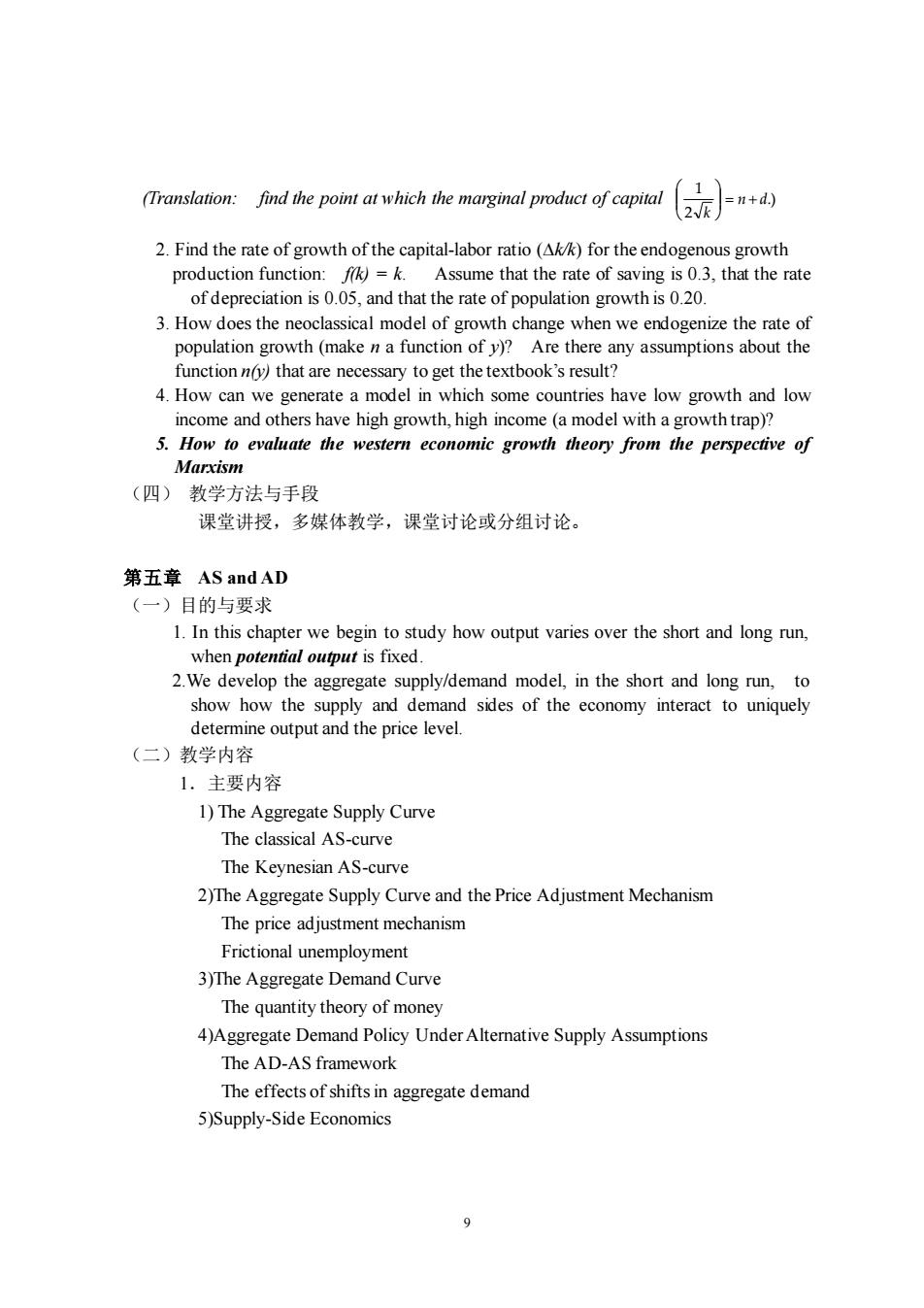
Transaon nd the pout c e rnpoct f epual 2.Find the rate of growth of the capital-labor ratio ()for the endogenous growth production function: Assume that the rate of saving is 0.3,that the rate of depreciation is 0.05,and that the rate of population growth is 0.20. 3.How does the neoclassical model of growth change when we endogenize the rate of population growth (makena function ofy)?Are there any assumptions about the toge the textbook's result? 4.How can we generate a model in which some countries have low growth and low income and others have high growth,high income (a model with a growth trap)? 5.How to evaluate the western economic growth theory from the perspective of Marxism (四)教学方法与手段 课堂讲授,多媒体教学,课堂讨论或分组讨论。 第五章AS andAD (一)目的与要求 1.In this chapter we begin to study how output varies over the short and long run, when potential output is fixed. 2.We develop the agg egate supply/demand model,in the short and long run,to now how the supp and sides of the economy interact to uniquely determine output and the price leve (二)教学内容 1.主要内容 1)The Aggregate Supply Curve The classical AS-curve The Keynesian AS-curve 2)The Aggregate Supply Curve and the Price Adjustment Mechanism The price adjustment mechanism Frictional unemployment 3)The Aggregate Demand Curve The quantity theory of money 4)Aggregate Demand Policy UnderAlterative Supply Assumptions The AD-AS framework The effects of shifts in aggregate demand 5)Supply-Side Economics
9 (Translation: find the point at which the marginal product of capital .) 2 1 n d k = + 2. Find the rate of growth of the capital-labor ratio (k/k) for the endogenous growth production function: f(k) = k. Assume that the rate of saving is 0.3, that the rate of depreciation is 0.05, and that the rate of population growth is 0.20. 3. How does the neoclassical model of growth change when we endogenize the rate of population growth (make n a function of y)? Are there any assumptions about the function n(y) that are necessary to get the textbook’s result? 4. How can we generate a model in which some countries have low growth and low income and others have high growth, high income (a model with a growth trap)? 5. How to evaluate the western economic growth theory from the perspective of Marxism (四) 教学方法与手段 课堂讲授,多媒体教学,课堂讨论或分组讨论。 第五章 AS and AD (一)目的与要求 1. In this chapter we begin to study how output varies over the short and long run, when potential output is fixed. 2.We develop the aggregate supply/demand model, in the short and long run, to show how the supply and demand sides of the economy interact to uniquely determine output and the price level. (二)教学内容 1.主要内容 1) The Aggregate Supply Curve The classical AS-curve The Keynesian AS-curve 2)The Aggregate Supply Curve and the Price Adjustment Mechanism The price adjustment mechanism Frictional unemployment 3)The Aggregate Demand Curve The quantity theory of money 4)Aggregate Demand Policy Under Alternative Supply Assumptions The AD-AS framework The effects of shifts in aggregate demand 5)Supply-Side Economics
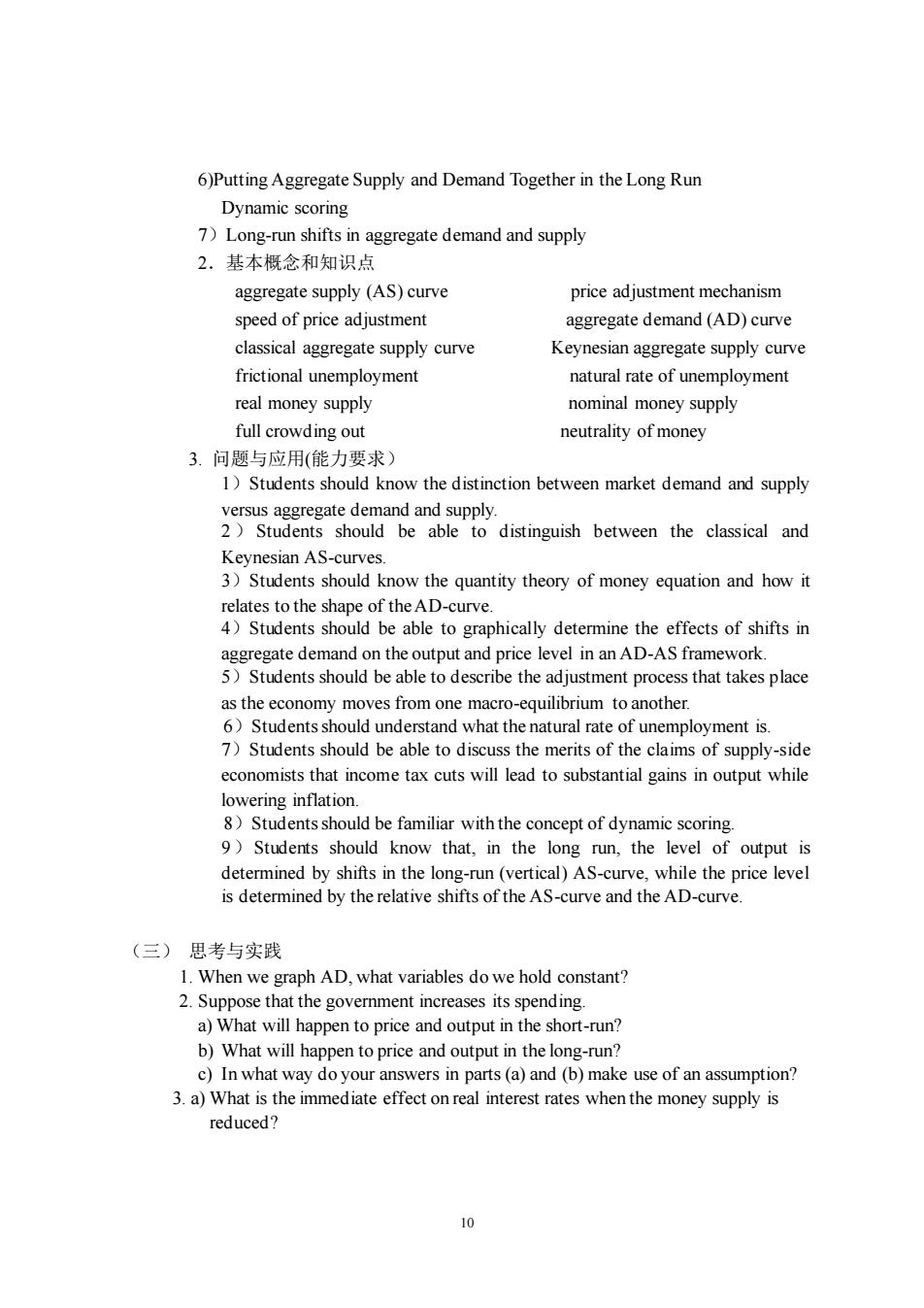
6)Putting Aggregate Supply and Demand Together in the Long Run Dynamic scoring 7)Long-run shifts in aggregate demand and supply 2.基本概念和知识点 aggregate supply (AS)curve price adiustment mechanism speed of price adjustment aggregate demand(AD)curve classical aggregate supply curve Keynesian aggregate supply curve frictional unemployment natural rate of unemployment real money supply nominal money supply full crowding out neutrality of money 3.问题与应用(能力要求) 1Students should know the distinction between market demand and supply Keynesian AS-curves. 3)students should know the quantity theory of money equation and how it -curve nts shou able to graphically determine the effects of shifts in aggregate demand on the output and price level in an AD-AS framework. 5)Students should be able to describe the adjustment process that takes place as the economy moves from one macro-equilibrium to another 6)Students should unde tand what the oyment is. should be able to dis f the claims of supply-side economists that income tax cuts will lead to substantial gains in output while lowering inflation. 8)Students should be familiar with the concept of dynamic scoring. 9)Students should know that,in the long run,the level of output is ermined by shifts in the long-run(vertical)AS-curve ile the price level is determined by the relative shifts of the AS-curve and the AD-curve (三) 思考与实践 1.When we graph AD,what variables do we hold constant? 2.Suppose that the government increases its spending. a)What will happen to price and output in the short-run? b)What will happen to price and output in the long-rur c)In what way do your answers in parts(a)and(b)make use of an assumption? 3.a)What is the immediate effect on real interest rates when the money supply is reduced? 10
10 6)Putting Aggregate Supply and Demand Together in the Long Run Dynamic scoring 7)Long-run shifts in aggregate demand and supply 2.基本概念和知识点 aggregate supply (AS) curve price adjustment mechanism speed of price adjustment aggregate demand (AD) curve classical aggregate supply curve Keynesian aggregate supply curve frictional unemployment natural rate of unemployment real money supply nominal money supply full crowding out neutrality of money 3. 问题与应用(能力要求) 1)Students should know the distinction between market demand and supply versus aggregate demand and supply. 2 ) Students should be able to distinguish between the classical and Keynesian AS-curves. 3)Students should know the quantity theory of money equation and how it relates to the shape of the AD-curve. 4)Students should be able to graphically determine the effects of shifts in aggregate demand on the output and price level in an AD-AS framework. 5)Students should be able to describe the adjustment process that takes place as the economy moves from one macro-equilibrium to another. 6)Students should understand what the natural rate of unemployment is. 7)Students should be able to discuss the merits of the claims of supply-side economists that income tax cuts will lead to substantial gains in output while lowering inflation. 8)Students should be familiar with the concept of dynamic scoring. 9)Students should know that, in the long run, the level of output is determined by shifts in the long-run (vertical) AS-curve, while the price level is determined by the relative shifts of the AS-curve and the AD-curve. (三) 思考与实践 1. When we graph AD, what variables do we hold constant? 2. Suppose that the government increases its spending. a) What will happen to price and output in the short-run? b) What will happen to price and output in the long-run? c) In what way do your answers in parts (a) and (b) make use of an assumption? 3. a) What is the immediate effect on real interest rates when the money supply is reduced?